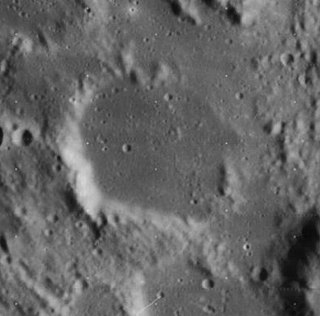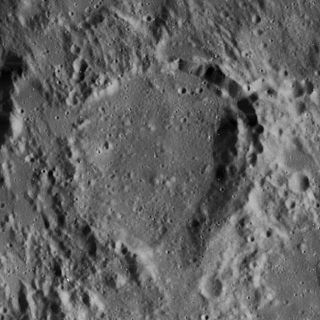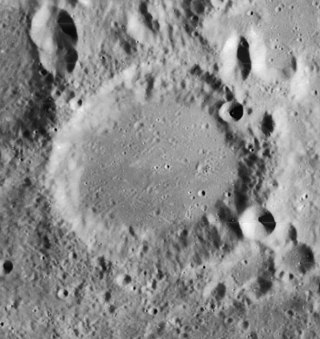
Daedalus is a prominent crater located near the center of the far side of the Moon. The inner wall is terraced, and there is a cluster of central peaks on the relatively flat floor. Because of its location, it has been proposed as the site of a future giant radio telescope, which would be scooped out of the crater itself, much like the Arecibo radio telescope, but on a vastly larger scale.

Blagg is a tiny lunar impact crater located on the Sinus Medii. It is a circular crater with no appreciable erosion. To the east-southeast is the irregular crater Rhaeticus, and northeast lies Triesnecker. It is about 33 km to the east of the slightly larger Bruce. It was named after noted English astronomer Mary Adela Blagg. Its diameter is 5.0 km.

Dembowski is a lunar impact crater located to the southeast of the Sinus Medii. Its diameter is 26 km. It was named after Italian astronomer Ercole Dembowski. To the east are the craters Agrippa and Godin, to the southwest is Rhaeticus.

Alpetragius is a lunar impact crater located on the eastern edge of Mare Nubium, to the southwest of the much larger crater Alphonsus. In the southeast is the prominent crater Arzachel, and to the west lies the flooded Lassell. Alpetragius is a Latinization of the name of Nur ad-Din al-Bitruji, a Spanish-Arab astronomer.

Rhaeticus is a lunar impact crater that lies astride the equator of the Moon, on the southeast edge of the Sinus Medii. To the north-northwest is the crater Triesnecker, and due south can be found the worn remnant of the walled plain Hipparchus. The crater was named after Austrian astronomer Georg Joachim Rheticus.

Capella is a lunar impact crater 49 km (30 mi) in diameter that lies to the north of the Mare Nectaris, in a rugged region with many small impact craters. It was named after Roman astronomer Martianus Capella. It intrudes slightly into the eastern rim of the crater Isidorus, a feature only slightly smaller in diameter.

Flammarion is a lunar impact crater on the south edge of Sinus Medii. Its diameter is 76 km. It is named after the French astronomer Camille Flammarion. It is located between the crater Mösting to the northwest and Herschel to the southeast. The bowl-shaped Mösting A intersects the western rim of Flammarion.

Alfraganus is a small lunar impact crater that lies in the rugged highland region to the southwest of the Mare Tranquillitatis. It is named after the Arab Muslim astronomer Alfraganus. Northwest of Alfraganus is the crater Delambre, and to the south is the irregular Zöllner. The rim of Alfraganus is circular and retains a sharp edge that has not received a significant amount of wear due to subsequent impacts. The interior floor is roughly half the diameter of the crater rim.

Aliacensis is a lunar impact crater that is located in the rugged southern highlands of the Moon. The crater Werner is located just to its north-northwest, and a narrow, rugged valley lies between the two comparably sized formations. To the southwest is Walther, and Apianus is to the northeast. Aliacensis is named after the 14th century French geographer and theologian Pierre d'Ailly in 1935. It is from the Nectarian period, which lasted from 3.92 to 3.85 billion years ago.

Delambre is a lunar impact crater that lies to the southwest of Mare Tranquillitatis, in the central highland region. To the west is the crater pair of Theon Junior and Theon Senior, the latter being more distant and located to the northwest.

Apianus is a lunar impact crater that is located on the rugged south-central highlands of the Moon. It is named after 16th century German mathematician and astronomer Petrus Apianus. It is located to the northeast of the crater Aliacensis, and to the northwest of Poisson. The worn crater Krusenstern is attached to the west-northwestern rim.

Geber is a lunar impact crater that is located in the rugged south-central highlands of the Moon. It lies halfway between the crater Almanon to the north-northeast and the crater pair of Azophi and Abenezra to the south-southwest. Farther to the southeast is Sacrobosco. Geber is 45 kilometers in diameter and 3,510 meters deep.

Donati is a lunar impact crater that is located in the rugged south-central highlands of the Moon. It lies just to the northwest of the crater Faye, and the two outer rims are separated by a gap of less than 10 kilometers. To the north is the comparably sized Airy, and farther to the southeast is Playfair. Donati is 36 kilometers in diameter.

Theon Senior is a lunar impact crater that is located to the northwest of the crater Delambre, and south of D'Arrest. It forms a matching pair with Theon Junior, about two crater diameters to the south-southeast. The satellite crater Theon Senior A can be found to the north. Theon Senior is named for Theon of Smyrna, a 1st-2nd century Greek mathematician and philosopher.

De Morgan is a small lunar impact crater that is located in the central region of the Moon, midway between the crater D'Arrest two crater diameters to the south, and Cayley to the north. Its diameter is 9.7 km. It is named after British logician Augustus De Morgan.

Curtius is a lunar impact crater that is located in the southern part of the Moon. From the Earth the crater appears foreshortened, making it more difficult to observe detail. Nevertheless, this is a large crater that can be readily found in even small telescopes. Curtius is located within one crater diameter of the still-larger Moretus to the southwest. To the northeast is the smaller Pentland. Curtius is 95 kilometers in diameter and 6.8 kilometers deep. It is from the Nectarian period, 3.92 to 3.85 billion years ago.

Hell is a lunar crater in the south of the Moon's near side, within the western half of the enormous walled plain Deslandres. To the southeast, also within Deslandres, is the larger crater Lexell, and about 9° to the south lies the prominent Tycho crater. The crater received its name in 1935 after the Hungarian astronomer and ordained Jesuit priest Maximilian Hell. It has 19 satellite craters with diameters ranging between about 3 and 22 km. Nearly all Hell craters are relatively flat and shallow, with a sharp, well-defined rim and a typical diameter-to-depth ratio of about 10.

Esclangon is a lunar impact crater that is located in the rugged terrain to the northwest of the prominent crater Macrobius, and east of Sinus Amoris. Its diameter is 15 km. It was named after French astronomer Ernest Esclangon. This formation was previously designated Macrobius L. Just to the west-southwest is the crater Hill. Lacus Bonitatis, the Lake of Good, is located to the east and northeast of Esclangon.

Chang Heng is a lunar impact crater that is located on the Moon's far side. It lies less than one crater diameter to the northeast of the walled plain Fleming. The rim of this crater is somewhat eroded, with a pair of small craters along the northern rim and tiny craters along the south and east edges. The interior floor contains a small, concentric crater that is about one third the diameter of Chang Heng. The crater is named after Chinese astronomer Zhang Heng.

Epimenides is a lunar impact crater that is located in the southwestern part of the Moon's near side, just to the east of the oddly shaped crater Hainzel. Just to the north and northeast is Lacus Timoris, a small lunar mare. The crater is 27 kilometers in diameter and 2,000 meters deep. It may be from the Pre-Nectarian period, 4.55 to 3.92 billion years ago.






















